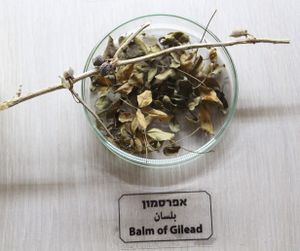Note: This is a project under development. The articles on this wiki are just being initiated and broadly incomplete. You can Help creating new pages.
Populus balsamifera - Balsam Poplar
Balm of Gilead was a rare perfume used medicinally, that was mentioned in the Bible, and named for the region of Gilead where it was produced. The expression stems from William Tyndale's language in the King James Bible of 1611, and has come to signify a universal cure in figurative speech.
Uses
Parts Used
Bark.
Chemical Composition
Common names
| Language | Common name |
|---|---|
| Kannada | |
| Hindi | |
| Malayalam | |
| Tamil | |
| Telugu | |
| Marathi | NA |
| Gujarathi | NA |
| Punjabi | NA |
| Kashmiri | NA |
| Sanskrit | |
| English | Balsam Poplar, Balm of Gilead |
Properties
Reference: Dravya - Substance, Rasa - Taste, Guna - Qualities, Veerya - Potency, Vipaka - Post-digesion effect, Karma - Pharmacological activity, Prabhava - Therepeutics.
Dravya
Rasa
Guna
Veerya
Vipaka
Karma
Prabhava
Habit
Identification
Leaf
| Kind | Shape | Feature |
|---|---|---|
| Simple | Alternate | Leaves are ovate or broadly lanceolate, 2.25 to 4.5 inches long (6-11 cm) and 1.5 to 3 inches wide (4-7.5 cm). |
Flower
| Type | Size | Color and composition | Stamen | More information |
|---|---|---|---|---|
| Unisexual | Pistillate and staminate catkins | Winter buds are 1 inch long (2.5 cm) with sticky resin and a pungent balsam odor in the spring. |
Fruit
| Type | Size | Mass | Appearance | Seeds | More information |
|---|---|---|---|---|---|
| Capsules | Ripe capsules split into 2 parts. Tiny seeds have a tuft of soft, white hairs at the tip and are often dispersed in large, fluffy masses | Fruiting occurs in late May to early or mid-July and when rivers are most often in the flood stage | {{{6}}} |
Other features
List of Ayurvedic medicine in which the herb is used
Where to get the saplings
Mode of Propagation
How to plant/cultivate
Seed - must be sown as soon as it is ripe in spring. Poplar seed has an extremely short period of viability and needs to be sown within a few days of ripening. Cuttings of mature wood of the current season's growth, 20 - 40cm long, November/December in a sheltered outdoor bed or direct into their permanent positions.[4]
Commonly seen growing in areas
Photo Gallery
References
External Links
- Ayurvedic Herbs known to be helpful to treat Fever
- Ayurvedic Herbs known to be helpful to treat Emaciation
- Ayurvedic Herbs known to be helpful to treat Debility
- Ayurvedic Herbs known to be helpful to treat Impaired digestion
- Ayurvedic Herbs known to be helpful to treat Diarrhea
- Ayurvedic Herbs known to be helpful to treat Urinary infections
- Herbs with Bark used in medicine
- Herbs with common name in English
- Habit - Tree
- Index of Plants which can be propagated by Seeds
- Index of Plants which can be propagated by Cuttings
- Herbs that are commonly seen in the region of Temperate area
- Herbs
- Plants of North America
- Salicaceae
- Ayurvedic herbs that don't have flower, fruit and leaf photos
- Ayurvedic herbs that don't have seed photos


